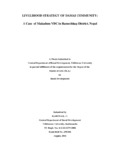Please use this identifier to cite or link to this item:
https://elibrary.tucl.edu.np/handle/123456789/2271| Title: | Livelihood Strategy of Damai Community |
| Other Titles: | A Case of Makadum VDC in Ramechhap District, Nepal |
| Authors: | K. C., Karuna |
| Keywords: | Living conditions;COMMUNITY |
| Issue Date: | Aug-2016 |
| Publisher: | Central Department of Rural Development, Tribhuvan University |
| Abstract: | This Thesis on the „Livelihood strategy of Damai community‟ was conducted in Makadum VDC of Ramechhap District. The study is focused on the marginalized ethnic group of Daami people and explores livelihood patterns of Damai community of Nepal. Conceptually livelihood connotes the means of activities entitlements and assets by which people make a living. It is related with both agriculture and non-agriculture sectors. The sources of livelihood of rural people are mainly threw cash crops, horticulture, animal husbandry, dairy, poultry, piggery, fishery, organic farming- vermin compost, handicrafts, rural artisans, and non-timber forest products etc. which are also followed by the Damai people of the study area. Dependence on wage labor, mostly of the unskilled and underpaid variety, is another important source of livelihood for majority of Damai in the study area. Damai unskilled labors migrate to the urban center for wage labor especially during lean agricultural periods. Damais have lots of hardship and drudgery in their livelihood earning. Research in Damai Tole of Makadum shows that historically people had their livelihood from wage laboring and Caste based occupation based activities. Land was a major household asset and crop production (Maize, millet, paddy, wheat etc) was the means of survival. But rapid urbanization and globalization pushed them in the transition providing both opportunities and constraints. The household assets have undergone rapid modification. Now they have no option other than modifying the traditional occupation. Land fragmentation, change in social institution, resulted from the urbanization and globalization. The livelihood diversification and introducing of foreign employment have recently emerged livelihood strategies of the people in the study area. Due to the proximity to the market, the influence of the urbanization is more apparent in the Damai Village. In the study area most of the households follow the multiple occupations besides agriculture. The role of agriculture activities in their life is substantial. Although a few households sell their crops, most of them sell the vegetable. The livelihood strategy of Damai community in the study area is in transition. It shifted from caste based occupation to wage loboring one. The household assets of vi this community have greatly influenced the process of adaptation of new strategy or modification of traditional occupation. Economic development and other economic activities change the surrounding environment of the people of a particular area have to change their way of life to adopt with the changing environment. Livelihood difficulty reflects on unprofitable Caste based occupation or un-remunerative employment, which may not even allow the poor family to meet their basic needs. So, it is inevitable to identify and disseminate the effective livelihood strategy, especially, for the improvement of livelihood of Damai. It is necessary to ensure access to resources and increase social and political participation of Damai community for integral development of rural community in Nepal. |
| URI: | http://elibrary.tucl.edu.np/handle/123456789/2271 |
| Appears in Collections: | Rural Development |
Items in DSpace are protected by copyright, with all rights reserved, unless otherwise indicated.

